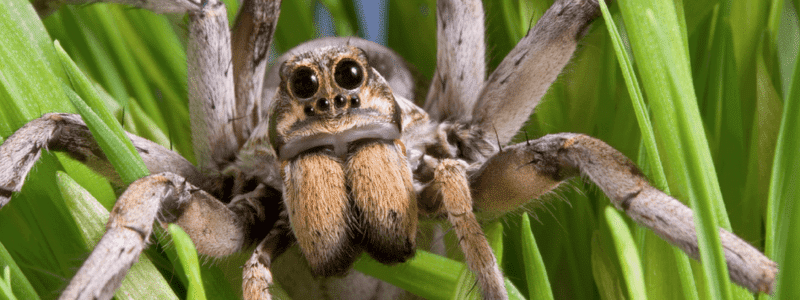Even if you know about wolf spiders in Arizona and other similar desert climates, learning about them is crucial to avoid a spider infestation on your property.
This guide includes:
- What do wolf spiders look like?
- Where do wolf spiders live?
- Are wolf spiders dangerous?
- What to do if a wolf spider bites you
- How to prevent wolf spider infestations
Use these spider pest extermination tips to protect you and your family from any potential home invasions and more.
What Do Wolf Spiders Look Like?
Wolf spiders are large and hairy. They are typically gray with brown or dark gray markings and are often mistaken for tarantulas or brown recluses.
However, these spiders have distinct differences in their shape, size, coloring, and habitat. There are also notable differences in where they live, how they nest, and what to be concerned with.
Where Do Wolf Spiders Live?

The wolf spider is found all across North America and most continents in the world. However, certain landscapes and climates, such as Arizona, provide them opportunities to live near humans easier than others.
This is because wolf spiders do not spin webs; instead, they create burrows or nests in bushes and trees. Houses, yards, and the plants surrounding them can create a beneficial environment that provides the structure for nests and the opportunity for food and water sources.
Are Wolf Spiders Dangerous?
Wolf spiders are not significantly aggressive toward humans, but they can cause damage if provoked. This is because:
- Wolf Spiders can bite and puncture human skin. Typical symptoms are redness and swelling but not much damage in excess.
- Wolf Spiders are not poisonous, but they are venomous.
- Wolf spiders are not venomous to humans, though sometimes there might be adverse allergic reactions to their bite or venom.
These attributes generally mean wolf spiders are not dangerous to humans – but their presence in your yard and home is still creating an unnecessary risk that you can avoid through proper prevention methods.
Read More: Homeowner’s Guide to Pest Control
What to Do if a Wolf Spider Bites You
Wolf Spider bites typically do not require professional medical attention unless there is an adverse allergic reaction. If a wolf spider bites you:
- Clean the puncture with soap and water, and then Neosporin
- Ice to reduce pain and swelling surrounding the wolf spider bite
- Wrap or bandage the wound to protect it
- Take Benadryl or other antihistamines should there be dizziness or other mild symptoms
- Seek professional medical help if there are significant symptoms past redness and swelling.
It is certainly not ideal to be bitten by a wolf spider, but for something that looks so menacing, its bite is usually no more harmful than a bee sting.
How to Prevent Wolf Spider Infestations

To keep wolf spiders out in Arizona, there are some simple measures you can take first:
- Keep other insects away: wolf spiders feed on insects and other pests. Use a vacuum to clear out areas inside your house or on a porch – the noise and motion will also disturb any wolf spiders near there.
- Seal Cracks and Crevices: any gaps in your doors, windows, or foundation of your house will be sufficient for wolf spiders to sneak in through.
- Get rid of extra clutter: cardboard boxes, newspapers, firewood piles, and any other debris can make a suitable hiding spot for wolf spiders.
- Trim back hedges and bushes: Wolf spiders often nest in trees and bushes; make sure to clear any overgrown or lean against your property, as these can create ideal nests and entry points for wolf spiders.
If you take these preventative measures, it will do wonders to keep wolf spiders off your property. However, if you see wolf spiders on your property, it may mean that there is already an infestation present. In that case, we recommend contacting professional pest control services immediately, as they will be able to save you time and money versus DIY attempts to remove wolf spiders from your home.







